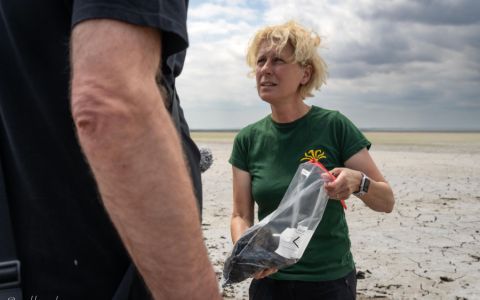YEREVAN – A conference on chemical safety in Armenian communities affected by mining took place on 14 December. Experts from the Czech non-governmental organization Arnika have summarised the worrying results of the programme Civil society involvement in chemical safety advocacy in Armenia, worked out jointly with local Centre for Community Mobilization and Support (CCMS) and the EcoLur non-governmental organization. The findings, based on two years of research, reveal a high and widespread presence of toxic elements such as arsenic and lead both in the environment and in biological samples taken from local residents.
Valeriya Grechko, a programme coordinator from Arnika, said: "Mining and ore processing activities have long been an integral part of Armenia's economy, providing valuable resources and employment opportunities. However, the lack of effective mitigation measures has resulted in a continuous release of toxic heavy metals into the environment. Our current findings provide a clear example of pollution in the vicinity of gold mines and related industries, not only in terms of soil, but also toxic substances in biological samples from local citizens. The set practice directly endangers their health with, for example, arsenic or mercury.”[1]
The two-year sampling was focused on the Ararat, Lori, Kotayk and Aragatsotn regions, specifically to a vicinity of pollution sources, such as Karaberd, Meghradzor, Tukhmanuk open-pit gold mines, the Ararat gold processing plant and its tailing ponds. Pathways of toxic heavy metals were inspected via 53 samples from a bottom sediment or soil and 83 biological samples taken from the local residents. Contains of arsenic, cadmium, chromium, copper, iron, mercury, molybdenum, nickel, lead, vanadium, and zinc were assessed by laboratories in Usti nad Labem and Prague (Czech Republic) under a support of the Ministry of Foreign Affairs of the Czech Republic. [2]
Oleg Dulgaryan, the CCMS, has led a discussion on the impact of mining activities on a health of the impacted communities and possible reforms. "Health problems of residents exposed to chemical pollution are becoming increasingly alarming. The Ministry of Health should take responsibility and conduct in-depth research and assessment of the health of people living in areas contaminated by mining," explained Dulgaryan.
The residents of these affected areas, who were directly involved in the sampling, were particularly interested in the results of the research. Hence, from 11 to 13 December, Arnika experts and partner teams from the Centre for Community Mobilization and Support and EcoLur have visited several such places, as Karaberd, Melikgyugh, Meghradzor or Ararat village, presenting information about the rates of heavy metals and other toxic elements in the analyzed samples.

There were also multiple discussions on minimizing the identified environmental and health risks. However, the breadth of the problem and its link to a key sector of the economy points first and foremost to the need for a systemic solution and the establishment of functional rules. If mitigation measures remain inadequate, there is a risk that a relatively large area around mines and other operations will be further contaminated with toxic substances. And, of course, the ultimate damage to the health of many people who now have very limited means of protecting themselves.

Detailed information
[1] - Main findings of the study – a summary:
Ararat, Surenavan:
Our results indicate that the environment in the area of Ararat could be classified as moderately to strongly polluted by arsenic, and moderately polluted by chromium and nickel. The mean concentration of lead in the soil samples (31.1 mg/kg DW) is higher than estimations. Concentrations of lead in two soil samples exceed the Armenian soil standard. Elevated concentrations of arsenic, cadmium, chromium and nickel in the soil were found in close proximity to the gold processing plant. The soil in some of the private gardens used for growing crops contain elevated levels of arsenic, lead, and zinc.
Urinary arsenic in the cohort seems higher than reference values elsewhere. Urinary copper may warrant caution, and urinary nickel was measured higher than reference values in the literature and elsewhere in Armenia. Several individuals with higher values of urinary cadmium, hair cadmium, and hair lead should be individually counselled.
Karaberd:
Our results also indicate that the environment in the area could be classified as moderately to heavily polluted by arsenic and cadmium, and moderately polluted by lead and zinc. The mean concentration of chromium in the soil samples (30.3 mg/kg DW) are lower than the worldwide average 60 mg/kg above, but any of the samples does not meet the Armenian soil standard for chromium. The pattern of occurrence of heavy metals in sediments in the Karaberd area raises the suspicion that the following heavy metals are being released into the river basin from the gold mine: arsenic, cadmium, copper, iron, mercury, molybdenum, nickel, lead, and zinc. Soils in some private gardens used for growing crops contain elevated levels of arsenic, cadmium, lead, and zinc.
Cadmium, copper, and nickel urinary levels in both cohorts, men and women, were measured considerably higher than reference values in other studies and warrant further examination of possible sources and clinical symptoms. Urinary arsenic in the Karaberd cohort indicates a moderate concern compared to reference values in the literature.
Meghradzor:
The pattern of occurrence of heavy metals in sediments in the Meghradzor area raises suspicion that the following heavy metals are being released into the river basin from the gold mine: arsenic, cadmium, copper, iron, mercury, molybdenum, nickel, lead, and zinc. Our results also indicate that the environment in the area could be classified as moderately polluted by arsenic. Soils in some private gardens used for growing crops contain elevated levels of arsenic, chromium, and lead.
Sediment samples with the highest arsenic concentrations, 29.6 mg/kg DW and 116 mg/kg DW, were collected from water streams flowing from and upstream of the gold mine, suggesting potential contamination from the mine and an unknown upstream source. Additionally, mining waste samples show elevated arsenic concentrations of 36.1 mg/kg DW and 39.7 mg/kg DW, further indicating the gold mine as a potential source of arsenic pollution.
In the female cohort in Meghradzor, urinary cadmium and nickel represent compounds of moderate to high level of concern. One female sample was tested for – moderate to high – level of copper in urine. In the male cohort, urinary copper and cadmium are the main compounds of concern in one of the tested individuals. An abnormally elevated levels of urinary arsenic were detected in the samples of a senior women (75 µg/g creatinine) and 5-year-old boy (37 µg/g creatinine).
Melikgyugh:
The pattern of heavy metals in sediments in the Melikgyugh area raises suspicions that arsenic and cadmium are being released into the river basin from the gold mine. Our results also indicate that the environment in the area could be classified as moderately to strongly polluted by arsenic, cadmium, and chromium. Soils in some private gardens used for growing crops contain elevated levels of chromium and zinc.
The sediment sample with a several times lower arsenic concentration was collected from a watercourse that drains an area where no mining is taking place. These findings could indicate that the gold mine may contaminate watercourse sediments with arsenic.
Out of the four women tested for urine heavy metals, one tested exceptionally high for arsenic and nickel, and her hair test results add concern for cadmium, copper, and mercury long-term exposures. The very participant should be examined for clinical symptoms related to heavy metals and counselled on preventive measures of exposure.
[2] - Contents of the sampling
The analysis has involved 55 environmental samples, of which 29 were taken from soil, 22 from sediments, one fish sample and three from a mining residue. The remaining one sample was from a fish. 83 biological samples were collected from residents of the impacted communities for an examination for concentrations of heavy metals. Those comprised of 55 urine samples and 28 hair samples.







